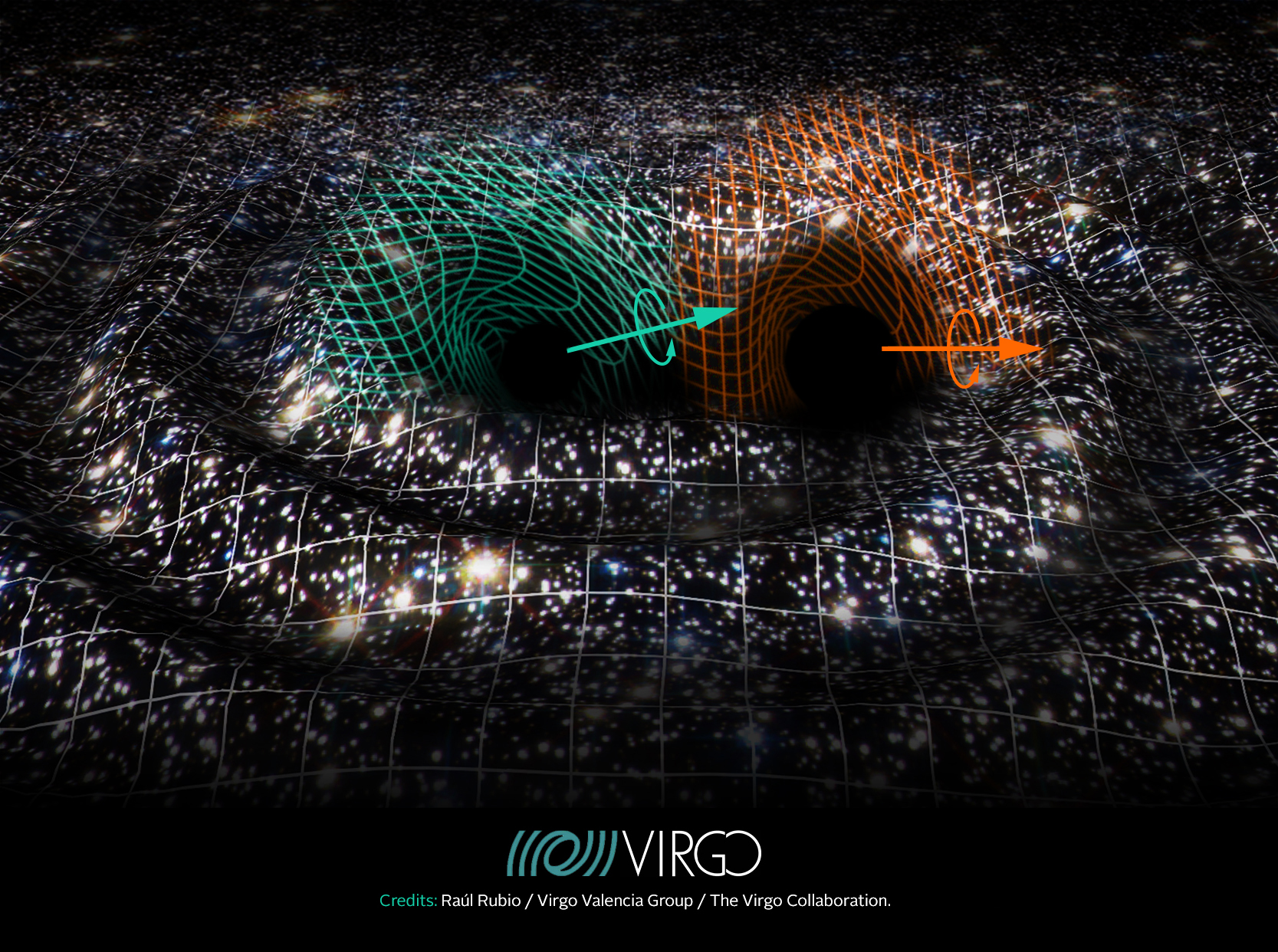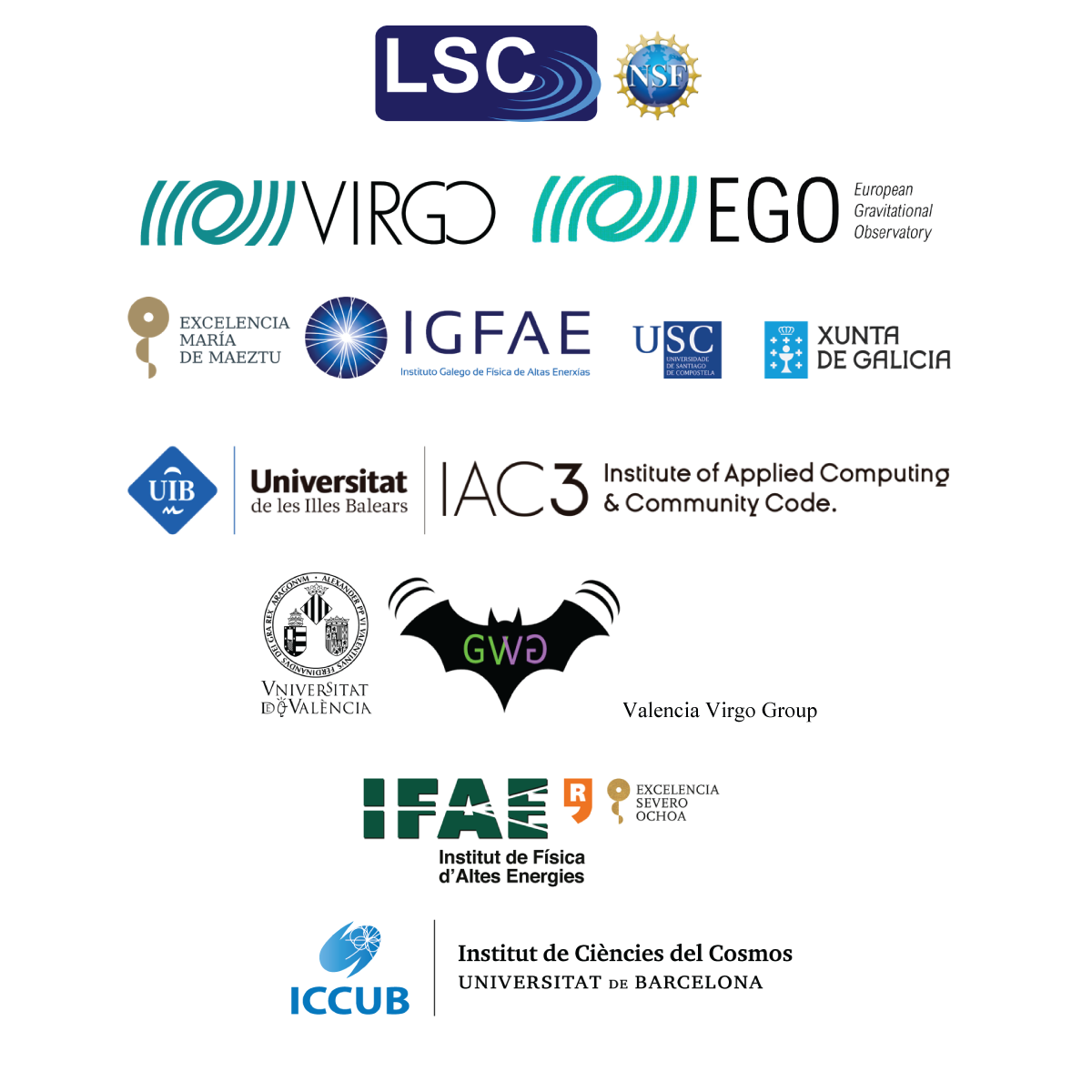IN THE PRESS
- 08/12/2015 - El Mundo (B@leópolis): Las ondas gravitacionales, en caza y captura
- 03/12/2015 - DICYT: 2016 será un gran año en la búsqueda de las ondas gravitacionales
- 23/11/2015 - La fábrica de la ciencia: Ondas gravitacionales,la música del Cosmos
- 19/11/2015 - SINC: A la caza de ondas gravitacionales
- 06/11/2015 - El Cultural: Los investigadores, ante las claves del universo
- 12/09/2015 - BALEARS FA CIÈNCIA (IB3Ràdio): La teoria de la relativitat i les ones gravitacionals Entrevista a les 12h, minut 22:50
- 10/09/2015 - El Mundo (B@leópolis): Una nueva ventana al universo
- 01/09/2015 - CPAN: LISA Pathfinder, en el camino al lanzamiento
- 26/06/2015 - Hipertextual: Este es el reto más importante de la física de la próxima década
- 2/12/2014 - El Mundo (B@leópolis): La banda de los agujeros negros
- 16/11/2014 - Diario de Mallorca: Ciencia en las estrellas del cine
- 1/04/2014 - El Mundo (B@leópolis): La primera foto del universo
- 1/02/2014 - Investigación y ciencia: Seísmos y ondas gravitacionales
- Investigación y Ciencia, February 2014
- 25/11/2009 - SINC: El universo busca la conciliación
- Campus Obert: Física después del bosón de Higgs
- Campus Obert: Intentando escuchar el Universo
- LIGO Flyer: Searching for continuous gravitational wave signals with the Hough transform
- Diario de Mallorca: "Europa destaca una recerca del Grup de Relativitat y Gravitació de la UIB"
- Prace Report 2012
- El Mundo (B@leópolis): "Sinfonía del universo en clave 2.0"
- Cadena Ser (A vivir que son dos días Baleares): Interview
- Diario de Mallorca: "A la recerca dels sons de l'univers"
- El Mundo (B@leópolis): "Relatividad y agujeros negros, contados para todos los públicos"
- ABC: "Una web sobre la relatividad de la UIB gana premio nacional de divulgación"
- Última Hora Column: "Einstein y las enanas blancas"
- Última Hora Column: "Sorprendente Convivencia"
- IB3 Radio Interview: "Descubierto el planeta extrasolar más cercano a la Tierra"
- Diario De Mallorca: "Los GPS tienen en cuenta la Teoría de la Relatividad para fijar la posición"
- Diari De Balears: "¿Hem trobat la partícula de Déu?"
- Diario de Mallorca: "Descubren la partícula que podría explicar el origen del universo"
- RNE Interview: "97 años de teoría de la relatividad"
- El Mundo News: "A la búsqueda del lado más oscuro del Universo"
- Última Hora Column: "Al acecho de la partícula divina"
- Última Hora Column: "Neutrinos con Prisa"
- Diario de Mallorca News: "Superordenadores al alcance de la UIB"
- ABC Interview: "Somos el único grupo español que participa en el proyecto LIGO"
- IB3 TV Interview: "La UIB millora la recerca dels forats negres"
- ABC News: "La UIB desarrolla un método para la detección de los agujeros negros"
- El Mundo News: "Científicos de Barcelona y Baleares participarán en rediseño del observatorio espacial LISA"
Seguir @UIBGRG
LIGO and Virgo unveil new and unexpected black hole populations
2 September, 2020
Virgo and LIGO have announced the detection of an extraordinarily massive merging binary system: two black holes of about 66 and 85 solar masses, which generated a final black hole of about 142 solar masses. Both the initial black holes, as well as the remnant, lie in a range of mass that has never before been observed, either via gravitational waves or with electromagnetic observations. The final black hole is the most massive ever detected with gravitational waves.

Seven billion years ago, at a distance of 17 billion light years, two black holes, of 66 and 85 solar masses, merged into a new massive black hole, of around 142 solar masses. Both the primary components and the remnant are in a higher mass range than has been observed to date, and the resulting black hole is the most massive black hole ever detected with gravitational waves.
This finding has been the result of 15 months of work by two major scientific collaborations ( Virgo and LIGO) that have had hundreds of experts from various countries, including Spanish participation.
The results obtained, as well as their scientific implications, have just been made known through two articles published in the journals Physical Review Letters and Astrophysical Journal Letters.
The massive binary system has been christened GW190521 – since the gravitational wave event was perceived on May 21, 2019
That the mass record detected by the Virgo and LIGO collaborations has been broken is an unprecedented discovery. “This detection opens the door to discovering many more possible new astrophysical effects,” says Thomas Dent, coordinator of the gravitational waves program at the Galician Institute of High Energy Physics (IGFAE) and member of the LIGO Scientific Collaboration.
Crucially, the remaining black hole is of intermediate mass, and this is related to one of the most fascinating and complex puzzles in astrophysics and cosmology: the origin of supermassive black holes. These giant monsters, millions to billions of times more massive than the Sun and often in the center of galaxies, could arise from the merger of smaller intermediate mass black holes.
“There must be mechanisms that we do not understand and that allow the generation of black holes with higher solar masses, such as supernovae,” explains researcher Alicia Sintes, from the University of the Balearic Islands (UIB) and member of LIGO
To date, very few such candidates have been identified solely through electromagnetic observations and this is the first observation via gravitational waves. Furthermore, the range of 100 to 1,000 solar masses has for many years represented a desert of black holes.
An unexplained phenomenon
Astrophysicists differentiate black holes into three groups based on their mass.
On the one hand, there are supermassive black holes, with a mass that ranges from hundreds of thousands to billions of times the mass of the Sun. This is the case of the black hole that is in the center of the Milky Way, with a mass about 4 million times that of the Sun. The way in which they were generated is still a mystery.
On the other hand, there are intermediate mass black holes, whose masses range between 100 and 100,000 times the mass of the Sun. Their origin is imprecise. This is the case of the perceived remnant, GW190521, which has been originated from the merger of two other massive masses.
Finally, there are stellar-mass black holes, whose mass is a few tens of times the solar mass. They are believed to have formed from the collapse of the core of a massive star, via supernova explosions.
One of the mysteries of the new find is the origin of the two parent black holes. “If they arose from the collapse of stars, they are in a mass range in which their presence is considered, in theory, impossible,” explains Dent. “Therefore, it could help improve our understanding of the final stages of the life of massive stars,” he predicts. If they can know and understand it, they could find out what is the origin of supermassive black holes, one of the most complex puzzles in astrophysics and cosmology.
It is known that black holes with masses between 65 and 120 times the mass of the Sun cannot have been formed after the collapse of a star. Through a phenomenon known as “pair instability”, when stars explode with these masses, they only leave behind a cloud of gas and cosmic dust, ‘making it impossible’ to form black holes of these dimensions.
Therefore, the astrophysical community would not expect to observe any black holes in this range of solar masses, between about 60 and 120. That is exactly the mass range in which the most massive component of GW190521 is found (66 and 85 solar masses ).
“Various scenarios predict the formation of black holes in the gap in the mass distribution due to pair instability: they could be the result of the merger of smaller black holes or the collision of (multiple) massive stars, or even of more exotic processes ”, adds Michela Mapelli from the University of Padua (Italy) and the Istituto Nazionale di Fisica Nucleare (INFN), in addition to belonging to the Virgo Collaboration.
“However, we may also need to revise our current understanding of the final stages of a star’s life and the constraints on final mass in black hole formation processes,” Mapelli continues.
Tito Dal Canton, a researcher at the Center National de la Recherche Scientifique (CNRS) at the Irène Joliot-Curie Lab, in Orsay, France, and a member of Virgo, explains that the initial black holes rotated rapidly.
“The signal shows signs of precession, a rotation of the orbital plane produced by rotations of great magnitude and particular orientation,” says Dal Canton. “The effect is weak and we cannot say that it is present in a categorical way, but if it were true, it would support the hypothesis that the parent black holes arise and live in very unstable and crowded cosmic environments, such as a dense star cluster or a disk. of accretion of an active galactic nucleus ”, predicts.
“It has been very complex to interpret the signal as it is at the limit of our technical capacity. We will only have a clear idea of how the system that generated it was formed after additional investigations and with future detections with which to compare ”, explains Thomas Dent, coordinator of the gravitational wave program at IGFAE.
“This event has really taken us to our limits: the complete analysis of this event and its through review by the collaboration have taken a large number of hard working researchers no less than 15 months! We have also been reminded that we do not yet have complete models of such signals: while we can describe precession reasonable well, general black holes might also have eccentric orbits — then they orbit on ellipses instead of circles when they are far apart. We are still working on including this effect before LIGO and Virgo observe more signals with the help of the Spanish Mare Nostrum supercomputer, one of the fastest computers in Europe”, says Sascha Husa, member of the LIGO group at UIB
This discovery has been made possible through a large international alliance of scientists from two major collaborations. on the one hand, the Virgo collaboration currently consists of some 580 members drawn from 109 institutions in 13 different countries, including Belgium, France, Germany, Greece, Hungary, Ireland, Italy, the Netherlands, Poland, Portugal and Spain. Virgo also contributes to the work one of the three detectors that have been necessary to detect the GW190521, located near Pisa, in Italy, within the European Gravitational Observatory.
On the other hand, more than 1,300 scientists from all over the world participate in the LIGO collaboration. this, for its part, provides two other detectors: one at the Livingston observatory, in Louisiana (USA) and another at the Hanford observatory, in Washington.
Regarding spanish participation, both the University of the Balearic Islands (UIB) and the Galician Institute of High Energy Physics (IGFAE) of the University of Santiago de Compostela (USC), are part of the LIGO Scientific Collaboration; while the Universitat de València (UV), the Institute of Cosmos Sciences of the University of Barcelona (ICCUB) and the Institut de Física d’Altes Energies (IFAE) of Barcelona are members of Virgo.

Links
- Virgo: http://www.virgo-gw.eu/gw190521/
- LIGO: https://www.ligo.org/detections/GW190521.php
- Science Summary: GW190521_Science_Summary_English.pdf
- Infographic: GW190521_Infographic.png
- Fact sheet: GW190521_Factsheet.pdf







